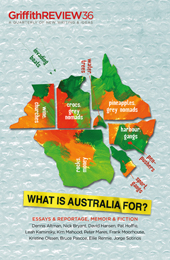Featured in

- Published 20120605
- ISBN: 9781921922534
- Extent: 264 pp
- Paperback (234 x 153mm), eBook

Already a subscriber? Sign in here
If you are an educator or student wishing to access content for study purposes please contact us at griffithreview@griffith.edu.au
Share article
More from author

Only connect
EssayDedicated to the memory of Michael Gordon (1955–2018) THE PEOPLES OF the Indian subcontinent have a significant presence in contemporary Australian culture: as the second-largest...
More from this edition

A good sport
GR OnlineIT'S ONE OF the most powerful images of the twentieth century: the Black Power salute at the 1968 Mexico City Olympics. It's an evocative...

Red truths and white lies
EssayIN 2004 I drove to the Wave Hill area of the Northern Territory. I had been contracted to assist its Gurindji residents to develop...

A market for a nation
Some ProvocationsAUSTRALIA WAS A nation established behind walls. The outward barriers of racially restrictive immigration, Commonwealth defence, and the desire for an inwardly free trade...